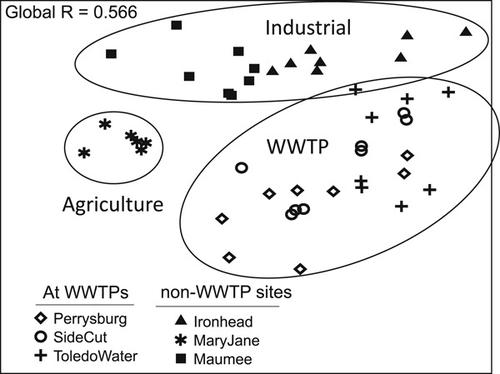当前位置:
X-MOL 学术
›
Environ. Toxicol. Chem.
›
论文详情
Our official English website, www.x-mol.net, welcomes your feedback! (Note: you will need to create a separate account there.)
Legacy and Contaminants of Emerging Concern in Tree Swallows Along an Agricultural to Industrial Gradient: Maumee River, Ohio.
Environmental Toxicology and Chemistry ( IF 4.1 ) Pub Date : 2020-06-04 , DOI: 10.1002/etc.4792 Christine M Custer 1 , Thomas W Custer 1 , Paul M Dummer 1 , Sandra Schultz 2 , Chi Yen Tseng 3 , Natalie Karouna-Renier 2 , Cole W Matson 3
Environmental Toxicology and Chemistry ( IF 4.1 ) Pub Date : 2020-06-04 , DOI: 10.1002/etc.4792 Christine M Custer 1 , Thomas W Custer 1 , Paul M Dummer 1 , Sandra Schultz 2 , Chi Yen Tseng 3 , Natalie Karouna-Renier 2 , Cole W Matson 3
Affiliation

|
Exposure to multiple classes of contaminants, both legacy and contaminants of emerging concern (CECs), were assessed in tree swallow (Tachycineta bicolor) tissue and diet samples from 6 sites along the Maumee River, Ohio, USA, to understand both exposure and possible effects of exposure to those CECs for which there are little avian data. The 6 sites represented a gradient from intensive agriculture upstream to highly urbanized and industrial landscapes downstream; 1 or 2 remote Wisconsin lakes were assessed for comparative purposes. Cytochrome P450 induction, DNA damage, and thyroid function were also assessed relative to contaminant exposure. Bioaccumulative CECs, such as polybrominated diphenyl ethers (PBDEs) and perfluorinated substances, did not follow any upstream to downstream gradient; but both had significantly greater concentrations along the Maumee River than at the remote lake sites. Greater exposure to PBDEs was apparent in swallows at or near wastewater‐treatment facilities than at other sites. Total polychlorinated biphenyl and total polycyclic aromatic hydrocarbon concentrations were greater in swallows at downstream locations compared to upstream sites and were associated with higher ethoxyresorufin‐O‐dealkylase activity. Few herbicides or nonorganochlorine insecticides were detected in swallow tissues or their food, except for atrazine and its metabolite desethylatrazine. Few pharmaceuticals and personal care products were detected except for DEET and iopamidol. Both were detected in most liver samples but not in eggs, as well as detected at the remote lake sites. This is one of the most comprehensive assessments to date of exposure and effects of a wide variety of CECs in birds. Environ Toxicol Chem 2020;39:1936–1952. © 2020 SETAC. This article has been contributed to by US Government employees and their work is in the public domain in the USA.
中文翻译:

沿农业到工业梯度发展的树燕子遗留问题的遗留问题和污染物:俄亥俄州莫米河。
在树燕子中(Tachycineta bicolor)评估了暴露于多种污染物的影响,包括传统污染物和新出现的污染物(CEC))来自美国俄亥俄州莫米河沿岸6个地点的组织和饮食样本,以了解暴露于鸟类数据很少的那些CEC的暴露及其可能的影响。这六个地点代表了从上游集约农业到下游高度城市化和工业景观的梯度;为了比较目的,评估了1个或2个威斯康星州的偏远湖泊。还评估了相对于污染物暴露的细胞色素P450诱导,DNA损伤和甲状腺功能。生物累积性CEC,例如多溴联苯醚(PBDEs)和全氟化物质,没有遵循任何从上游到下游的梯度;但是在莫米河沿岸,这两个地区的浓度都比偏远的湖泊要大得多。与其他场所相比,废水处理设施中或附近的燕子中多溴二苯醚的暴露量明显增加。与上游位置相比,下游地区燕子中的多氯联苯和多环芳烃总浓度更高,与更高的乙氧基间苯二酚O-脱烷基酶活性。在吞咽组织或其食物中,除阿特拉津及其代谢产物脱乙基阿特拉津以外,几乎没有发现除草剂或非有机氯杀虫剂。除DEET和碘帕醇外,几乎没有检测到任何药品和个人护理产品。在大多数肝脏样品中都检测到了这两种蛋白,但在卵子中也未检测到这两种蛋白,在偏远的湖泊中也检测到了这两种蛋白。这是迄今为止对鸟类中各种CEC的暴露及其影响的最全面的评估之一。环境毒性化学2020; 39:1936–1952。©2020 SETAC。本文由美国政府雇员提供,其工作属于美国的公共领域。
更新日期:2020-06-04
中文翻译:

沿农业到工业梯度发展的树燕子遗留问题的遗留问题和污染物:俄亥俄州莫米河。
在树燕子中(Tachycineta bicolor)评估了暴露于多种污染物的影响,包括传统污染物和新出现的污染物(CEC))来自美国俄亥俄州莫米河沿岸6个地点的组织和饮食样本,以了解暴露于鸟类数据很少的那些CEC的暴露及其可能的影响。这六个地点代表了从上游集约农业到下游高度城市化和工业景观的梯度;为了比较目的,评估了1个或2个威斯康星州的偏远湖泊。还评估了相对于污染物暴露的细胞色素P450诱导,DNA损伤和甲状腺功能。生物累积性CEC,例如多溴联苯醚(PBDEs)和全氟化物质,没有遵循任何从上游到下游的梯度;但是在莫米河沿岸,这两个地区的浓度都比偏远的湖泊要大得多。与其他场所相比,废水处理设施中或附近的燕子中多溴二苯醚的暴露量明显增加。与上游位置相比,下游地区燕子中的多氯联苯和多环芳烃总浓度更高,与更高的乙氧基间苯二酚O-脱烷基酶活性。在吞咽组织或其食物中,除阿特拉津及其代谢产物脱乙基阿特拉津以外,几乎没有发现除草剂或非有机氯杀虫剂。除DEET和碘帕醇外,几乎没有检测到任何药品和个人护理产品。在大多数肝脏样品中都检测到了这两种蛋白,但在卵子中也未检测到这两种蛋白,在偏远的湖泊中也检测到了这两种蛋白。这是迄今为止对鸟类中各种CEC的暴露及其影响的最全面的评估之一。环境毒性化学2020; 39:1936–1952。©2020 SETAC。本文由美国政府雇员提供,其工作属于美国的公共领域。


























 京公网安备 11010802027423号
京公网安备 11010802027423号